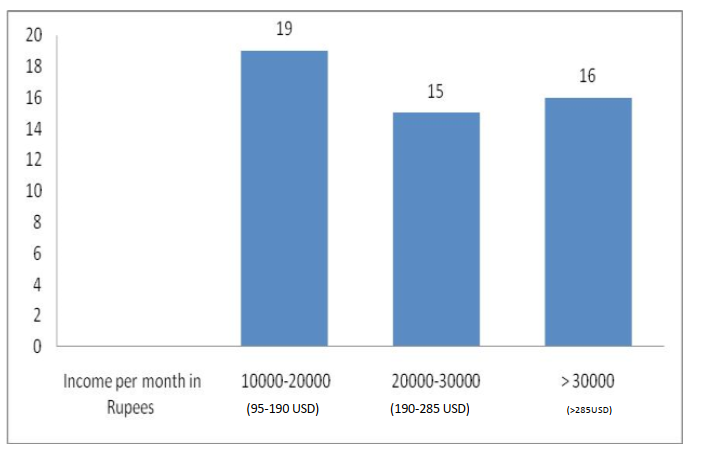Abstract
Background:
Stillbirth (SB) incidents are one of the most common adverse
outcomes to occur during pregnancy. Studies indicate that approximately
3.3 million stillbirths are reported annually across the developing world.
Institutional registration and under reporting of still birth to an authorized
centre is a common problem.
Objective:
The objective of this study is to
find out the incidence of SB after 28 weeks gestation and to find out the
associated risk factors at Western Regional Hospital of Nepal.
Materials and Methods:
This is a cross sectional study carried out at Western
Regional Hospital. Stillbirth babies born after 28 weeks of gestation or
birth weight ≥ 1 kilogram and their mothers were recruited for the study.
Intrapartum stillbirths were included despite of their ages, races or socioeconomic status. Descriptive analysis was done on the data.
Results:
There were 3380 deliveries during the period of study. Among them, 50 cases
were stillborn babies with a rate of 14 per thousand deliveries. The major
risk factors associated were oligohydramnios, decreased fetal movement,
growth restriction, meconium stained liquor and cord prolapse.
Conclusion:
Oligohydramnios (amniotic fluid index < 5cm) was the most common
risk factor for stillbirth. Early identification and appropriate perinatal
management could help to promote perinatal health.
References
Am J Obstet Gynecol. 2003; 189(3):861-73.
2. Lawn JE, Cousens S, Zupan J. 4 million neonatal deaths: when?
Where? Why? Lancet. 2005; 365(9462):891-900
3. Ghimire PR, Agho KE, Renzaho A. Socio-economic predictors
of stillbirths in Nepal (2001-2011). PLoS ONE. 2017; 12(7):
e0181332.
4. Elizabeth M. McClure, Robert L. Goldenberg. Stillbirth in
Developing Countries: A review of causes, risk factors and
prevention strategies. Int J Gynecology Obstet. 2006;94:82-90
5. Joy Lawn, Kenji Shibuya, and Claudia Stein. No cry at birth:
global estimates of intra partum stillbirths and intra partum-related
neonatal deaths. Bull World Health Organ. 2005; 83(6):409–17.
6. KC Ashish, Johan Wrammert, Uwe Ewald et al. Incidence of
intrapartum stillbirth and associated risk factors in tertiary care
setting of Nepal: a case-control study. Reproductive Health.
2016;13:103
7. March of Dimes, PMNCH, Save the Children, World Health
Organization (WHO). Born too soon: the global action report on
preterm birth. Geneva: World Health Organization; 2012.
8. Lawn JE, Blencowe H, Pattinson R. Stillbirths: Where? When?
Why? How to make the data count? Lancet. 2011; published
online April 14. DOI:10.1016/S0140-6736(10)62187-3.
9. “Placental, pregnancy conditions account for most stillbirths”
Archived 2013-08-01 at the Wayback Machine.U.S. Department
of Health and Human Services. NIH News (December 13, 2011).
Retrieved 2013-08-30.
10. Shrestha SR, Yadav BK. Risk factors associated with still births.
J Nepal Med Assoc. 2010;49(177):84-7.
11. Stillbirth rates alarming in India, Pakistan. The Hans of
India. Retrieved from http://www.thehansindia.com/posts/
index/Hans/2016-01-25/Stillbirth-rates-alarming-in-IndiaPakistan/202392
12. Lee AC, Mullany LC, Tielsch JM, Katz J, Khatry SK, LeClerg
SC, et al. Community-based stillbirth rates and risk factors in rural
Sarlahi, Nepal. International Journal of Gynecology & Obstetrics.
2011;113:199–204.
13. Ashish KC, Nelin V, Wrammert J, Ewald U, Vitrakoti R, Baral
GN, et al. Risk factors for antepartum stillbirth: a case-control
study in Nepal. BMC Pregnancy Childbirth. 2015;15:146 doi:
10.1186/s12884-015-0567-3
14. Nahar S, Rahman A, Nasreen HE. Factors influencing stillbirth
in Bangladesh: a case-control study. Paediatric Perinatal
Epidemiology. 2013;27:158–64.
15. Suleiman BM, Ibrahim HM, Abdulkarim N. Determinants of
stillbirths in katsina, Nigeria: a hospital-based study. Paediatric
reports. 2015;7:5615
16. Manandhar SR, Ojha A, Manandhar DS, Shrestha B, Shrestha
D, Saville N, et al. Causes of stillbirths and neonatal deaths in
Dhanusha district, Nepal: a verbal autopsy study. University
Medical Journal. 2010;8:62–72.
17. Ministry of Health [Nepal], New ERA, and ORC Macro.
2002. Nepal Demographic and Health Survey 2001 Calverton,
Maryland, USA: Family Health Division, Ministry of Health;
New ERA; and ORC Macro.
18. Ministry of Health and Population (MOHP) [Nepal], New ERA,
and Macro International Inc. 2007. Nepal Demographic and
Health Survey 2006 Kathmandu, Nepal: Ministry of Health and
Population, New ERA, and Macro International Inc.
19. Jorgensen AL, Alfirevic Z, Tudur Smith C, Williamson PR,
Cerclage IPD Meta-analysis Group. Systemic review: Cervical
stitch (cerclage) for preventing pregnancy loss: individual patient
data meta-analysis. BJOG. 2007;114:1460
20. Ott WJ. Reevaluation of the relationship between amniotic
fluid volume and perinatal outcome. Am J Obstet Gynecol.
2005;192:1803
21. Unterscheider J, Horgan R, O’Donoghue K, Greene R. Reduced
fetal movements. The Obstetrician & Gynaecologist. 2009;
11:245–51.
22. Sergent F, Lefevre A, Verspyck E, Marpeau L. Decreased fetal
movements in the third trimester: what to do? Gynecol Obstet
Fertil 2005; 33:861–9.
23. Heazell AE, Green M, Wright C, Flenady V, Froen JF. Midwives
and obstetricians knowledge and management of women
presenting with decreased fetal movements. Acta Obstet Gynecol
Scand. 2008;87:331–9
24. Fetal hypoxia and meconium in pre term deliveries and stillbirth.
D. Staribratova, V. Belovejdov. Trakia Journal of Sciences.
2011;9(2):45-8.
25. Stillbirth Collaborative Research Network Writing Group.
“Causes of death among stillbirths.” JAMA. 2011; 306(22):2459-
68.
26. Reddy UM, Goldenberg R, Silver R, G. C. S., Pauli, R. M.,
Wapner, R. J et al. Stillbirth Classification—Developing an
International Consensus for Research: Executive Summary of
a National Institute of Child Health and Human Development
Workshop. Obstetrics and gynecology. 2009;114(4):901-14.
27. JEHAN, Imtiaz; McCLURE, Elizabeth M; SALAT, Sohail;
RIZVI, Sameera; PASHA, Omrana; HARRIS, Hillary et al.
Neonatal mortality, risk factors and causes: a prospective
population-based cohort study in urban Pakistan. Bull World
Health Organ. 2009; 87(2):130-8.
28. Weiner R, Ronsmans C, Dorman E, Jilo H, Muhoro
A, Shulman C. Labour complications remain the most
important risk factors for perinatal mortality in rural
Kenya. Bull World Health Organ. 2003;81(8):561-6. Epub
2003 Oct 14.

